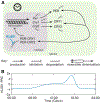Nonlinear Model Predictive Control For Circadian Entrainment Using Small-Molecule Pharmaceuticals
- PMID: 33842933
- PMCID: PMC8034286
- DOI: 10.1016/j.ifacol.2017.08.1596
Nonlinear Model Predictive Control For Circadian Entrainment Using Small-Molecule Pharmaceuticals
Abstract
Recent in vitro studies have identified small-molecule pharmaceuticals effecting dose-dependent changes in the mammalian circadian clock, providing a novel avenue for control. Most studies employ light for clock control, however, pharmaceuticals are advantageous for clock manipulation through reduced invasiveness. In this paper, we employ a mechanistic model to predict the phase dynamics of the mammalian circadian oscillator under the effect of the pharmaceutical under investigation. These predictions are used to inform a constrained model predictive controller (MPC) to compute appropriate dosing for clock re-entrainment. Constraints in the formulation of the MPC problem arise from variation in the phase response curves (PRCs) describing drug effects, and are in many cases non-intuitive owing to the nonlinearity of oscillator phase response effects. We demonstrate through in-silico experiments that it is imperative to tune the MPC parameters based on the drug-specific PRC for optimal phase manipulation.
Keywords: Biological control; circadian oscillator; model predictive control; phase response curve; time-varying weights.
Figures




Similar articles
-
Pharmacokinetic Model-Based Control across the Blood-Brain Barrier for Circadian Entrainment.Int J Mol Sci. 2023 Oct 2;24(19):14830. doi: 10.3390/ijms241914830. Int J Mol Sci. 2023. PMID: 37834278 Free PMC article.
-
Pharmaceutical-based entrainment of circadian phase via nonlinear model predictive control.Automatica (Oxf). 2019 Feb;100:336-348. doi: 10.1016/j.automatica.2018.11.012. Epub 2018 Dec 10. Automatica (Oxf). 2019. PMID: 31673164 Free PMC article.
-
Compensating for Sensor Error in the Model Predictive Control of Circadian Clock Phase.IEEE Control Syst Lett. 2019 Oct;3(4):853-858. doi: 10.1109/lcsys.2019.2919438. Epub 2019 May 28. IEEE Control Syst Lett. 2019. PMID: 33748651 Free PMC article.
-
Temperature effect on entrainment, phase shifting, and amplitude of circadian clocks and its molecular bases.Chronobiol Int. 2002 Sep;19(5):807-64. doi: 10.1081/cbi-120014569. Chronobiol Int. 2002. PMID: 12405549 Review.
-
Time optimal entrainment control for circadian rhythm.PLoS One. 2019 Dec 18;14(12):e0225988. doi: 10.1371/journal.pone.0225988. eCollection 2019. PLoS One. 2019. PMID: 31851723 Free PMC article. Review.
Cited by
-
Pharmacokinetic Model-Based Control across the Blood-Brain Barrier for Circadian Entrainment.Int J Mol Sci. 2023 Oct 2;24(19):14830. doi: 10.3390/ijms241914830. Int J Mol Sci. 2023. PMID: 37834278 Free PMC article.
-
Pharmaceutical-based entrainment of circadian phase via nonlinear model predictive control.Automatica (Oxf). 2019 Feb;100:336-348. doi: 10.1016/j.automatica.2018.11.012. Epub 2018 Dec 10. Automatica (Oxf). 2019. PMID: 31673164 Free PMC article.
-
A dual-feedback loop model of the mammalian circadian clock for multi-input control of circadian phase.PLoS Comput Biol. 2020 Nov 23;16(11):e1008459. doi: 10.1371/journal.pcbi.1008459. eCollection 2020 Nov. PLoS Comput Biol. 2020. PMID: 33226977 Free PMC article.
References
-
- Andersson J, Akesson J, and Diehl M (2012). Recent Advances in Algorithmic Differentiation, volume 87. Springer; Berlin Heidelberg.
-
- Bagheri N, Stelling J, and Doyle III FJ (2007). Circadian phase entrainment via nonlinear model predictive control. Int. J. Robust Nonlinear Control, 17(May), 1555–1571.
-
- Bemporad A, Morari M, and Ricker NL (2004). Model Predictive Control Toolbox User’s Guide. The Math-works, Inc.
Grants and funding
LinkOut - more resources
Full Text Sources
